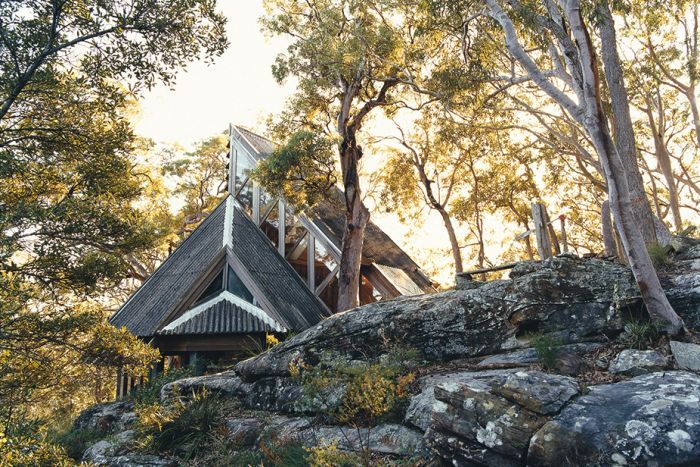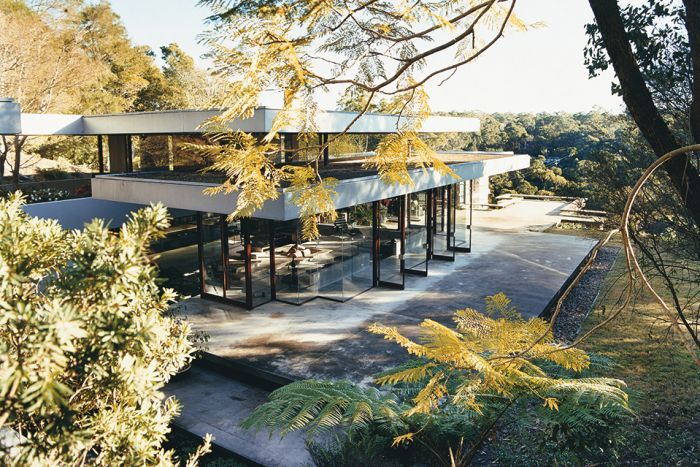Iconic Australian Houses on display in Canberra represent antithesis in 'world of renovation'
Updated
 Photo:
The Lobster Bay House in New South Wales designed by architect Ian McKay. (Supplied: NAA/Michael Wee)
Photo:
The Lobster Bay House in New South Wales designed by architect Ian McKay. (Supplied: NAA/Michael Wee)
Some of the nation's most artistically significant homes have gone on show in a new multimedia exhibition at the National Archives of Australia in Canberra.
Iconic Australian Houses was originally commissioned as two books by publisher Murdoch Books.
But thanks to Sydney Living Museums and the Architecture Foundation of Australia, the collection later became an exhibition, which first went on show at the Museum of Sydney.
The exhibition has since travelled to regional centres including Dubbo, Port Macquarie, Newcastle and Wagga Wagga.
It includes still photos of residences, 2D and 3D plans, architectural models and video interviews with architects and home owners.
 Photo:
The Hildebrand House on the Mornington Peninsula, in Victoria, designed by Robinson Chen architects. (Supplied: NAA/Michael Wee)
Photo:
The Hildebrand House on the Mornington Peninsula, in Victoria, designed by Robinson Chen architects. (Supplied: NAA/Michael Wee)
Curator Karen McCartney said there was only one apartment, located in Surry Hills, among the collection of mostly stand-alone houses from every jurisdiction except South Australia and the Northern Territory.
"The word iconic has become very overplayed," Ms McCartney said.
"Everything is iconic these days, but I did have a very strict criteria for houses to live up to that term."
Ms McCartney said that criteria included the home exterior and interior being intact.
"We live in a world of renovation," Ms McCartney said.
"It is hard to find things that haven't been altered and where interiors match the exterior.
"They had to reflect the original intent of the architect."
 Photo:
The Rosenburg House in Turramurra, New South Wales, designed by architect Neville Gruzman. (Supplied: NAA/Michael Wee)
Photo:
The Rosenburg House in Turramurra, New South Wales, designed by architect Neville Gruzman. (Supplied: NAA/Michael Wee)
Designs also must have broken new ground architecturally at the time and be conceptually interesting.
"Many are modest houses, particularly post-war, where architects showed ingenuity and responded to the landscape," Ms McCartney said.
"They are not necessarily showy houses."
90yo architect laments contemporary housing design
 Photo:
The Dingle House in the ACT designed by architect Enrico Taglietti. (Supplied: NAA/Michael Wee)
Photo:
The Dingle House in the ACT designed by architect Enrico Taglietti. (Supplied: NAA/Michael Wee)
Properties appearing in the exhibition must also have been designed by significant architects, like Enrico Taglietti who designed Dingle House in the Canberra suburb of Hughes.
The Dingle House takes its name from the surname of the home's first owner in the mid 1960s.
It is the only ACT residence to feature in the book and exhibition.
"I feel like the grandfather of it," Mr Taglietti said.
"The house was designed as a one-off for the owner. The number of bedrooms didn't matter."
Mr Taglietti has designed around 50 Canberra properties, including a library, four schools, four embassies, the Old Sunset Cinema, storage for the Australian War Memorial and one church.
 Photo:
The Gottlieb House in Melbourne designed by Wood Marsh architects. (Supplied: NAA/Michael Wee)
Photo:
The Gottlieb House in Melbourne designed by Wood Marsh architects. (Supplied: NAA/Michael Wee)
Mr Taglietti, now aged 90, continues to design but said he lamented the state of contemporary design in the ACT.
"Canberra now has too many rules and design is being totally driven by profit rather than dreams," he said.
Mr Taglietti originally left Milan in Italy and arrived in Australia in 1955 to curate an exhibition in Sydney.
He was only expecting to visit for six weeks but he ended up making a life in Canberra after falling in love with the location.
"The silence, natural light and the blank slate," Mr Taglietti said.
"It was a time when everyone was hoping that Canberra would become the most liveable city in the world.
"There was a much bolder vision for Canberra then."
Mr Taglietti said that bold vision related to Canberra being controlled at the time by the Federal Government, before the territory was established.
Topics: house-and-home, industrial-design, design, library-museum-and-gallery, canberra-2600, act, australia
First posted









